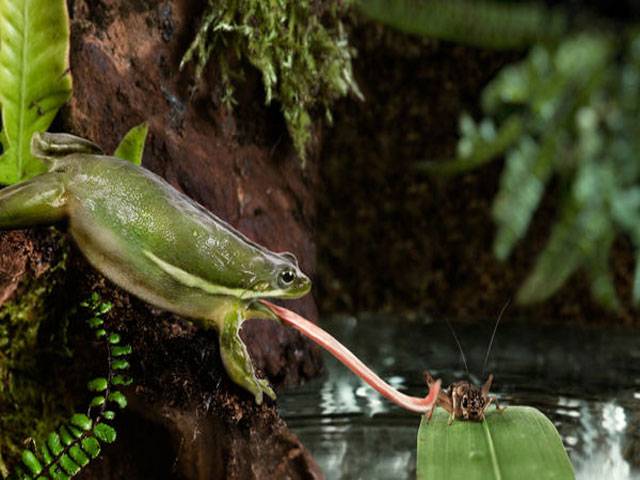BBC
LONDON
New research shows that the pulling force of a frog’s tongue can be up to three times the animal’s own weight.
Zoologists placed the horned frog, a predator known to swallow whole mice, in front of a glass slide and tempted it with a tasty cricket. Stronger pulling forces were measured when contact with the glass was briefer and less mucus was left behind.
The study, from the journal Scientific Reports, suggests the action of the tongue is similar to sticky tape. ‘It’s the first time we’ve ever measured how well frog tongues stick,’ said Dr Thomas Kleinteich, who performed the experiments at the University of Kiel in Germany.
Dr Kleinteich works in a group that studies biological adhesives, includinggecko and beetle feet, with a view to finding new designs for sticky applications like boot soles, tapes and parcel closures. ‘The thing that’s interesting about frog tongues is that they’re really fast,’ he told BBC News. ‘It only takes milliseconds.’
The South American horned frog in particular, a popular pet, is known for its ability to snatch morsels up to half its own size - from locusts and fish to other amphibians and small rodents. In the wild, they lurk half-buried in wait for their prey, and then ‘they swallow pretty much everything that fits into their mouths,’ Dr Kleinteich said.
To study this combination of strength and speed, he bought four horned frogs from local pet shops. During their regular feeding routine, he presented each frog with an adult cricket behind a glass slide, attached to a transducer that recorded the forces exerted by the frog’s tongue. On average, these forces were larger than the weight of the frog itself, and in the case of one young amphibian more than three times larger.
After each trial, the equipment was removed and the frog got its treat. Dr Kleinteich ultimately needed twenty measurements from each frog, so the predators had to be kept happy. Looking at the slides afterwards, the ‘tongue print’ left behind on the glass slide offered more insights, including massive variation in the proportion of the contact area that was covered by mucus.
Friday, April 19, 2024
Frog’s tongue lifts 3 times own body weight

Caption: Frog’s tongue lifts 3 times own body weight
Helicopter crash kills Kenya defence chief
April 19, 2024
IHCBA moves SC for probe into judges’ allegations
April 19, 2024
Two school girls wounded in knife attack in France
April 19, 2024
Death toll swells as country braces for more rains
April 19, 2024
US, UK unveil sweeping sanctions on Iran’s drone program
April 19, 2024
Hepatitis Challenge
April 18, 2024
IMF Predictions
April 18, 2024
Wheat War
April 18, 2024
Rail Revival
April 17, 2024
Addressing Climate Change
April 17, 2024
Justice denied
April 18, 2024
AI dilemmas unveiled
April 18, 2024
Tax tangle
April 18, 2024
Workforce inequality
April 17, 2024
New partnerships
April 17, 2024
ePaper - Nawaiwaqt
Advertisement
Nawaiwaqt Group | Copyright © 2024





